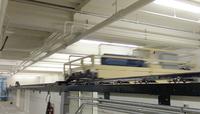Old tool, new research
Refurbished towing tank enables more experimentation in hydraulics and hydrology
The Purdue University Civil Engineering Hydraulics and Hydrology Group will be making waves — literally — this school year.
This fall, the Lyles School towing and wave tank will be fully operational. The 150-foot-long, 11-foot-wide and 5-foot-deep water basin will be used for coastal engineering and fluid dynamics research. It is located in the basement of Hampton Hall, in the Christopher and Susan Burke Hydraulics and Hydrology Laboratory.
“We’re all very excited about what this can do for our research,” says Cary Troy, associate professor of civil engineering. “We have spent years working on this project, and we are happy to have it up and working.”
With a large carriage affixed to the top — which can move as fast as 5 meters per second — the tank will be used in a wide range of hydrodynamic and coastal engineering studies. A wave maker has been installed to study coastal erosion effects and wave forces. Additionally, the tank is equipped with a water-filtration system, viewing ports to monitor flow, a 3-D particle image velocimetry system, wave gauges, and load cells to measure fluid forces on towed objects.
History Revived
The towing tank was originally constructed in the 1960s along with Hampton Hall itself. However, over the decades, the tank fell into disrepair. It has not been used since 2007.
Preparations for the renovations began about four years ago, when the Civil Engineering and Mechanical Engineering schools received a grant from Purdue to overhaul the facility.
“We expect this to help set Purdue apart as one of the best civil engineering schools in the world and to provide us with greater and more conveniently located research opportunities,” Troy says. “Also, it’s just nice to restore a piece of our school’s history.”
Rao “G.S.” Govindaraju, the Bowen Engineering Head and Christopher B. and Susan S. Burke Professor of Civil Engineering, says he is excited to see the new research opportunities the towing tank will provide.“We are always looking to improve and add to our school so that our students, faculty and staff can have the best resources available to them,” Govindaraju says. “Not only will this create new avenues for research, it revitalizes our facility and restores some of our venerable history.”


